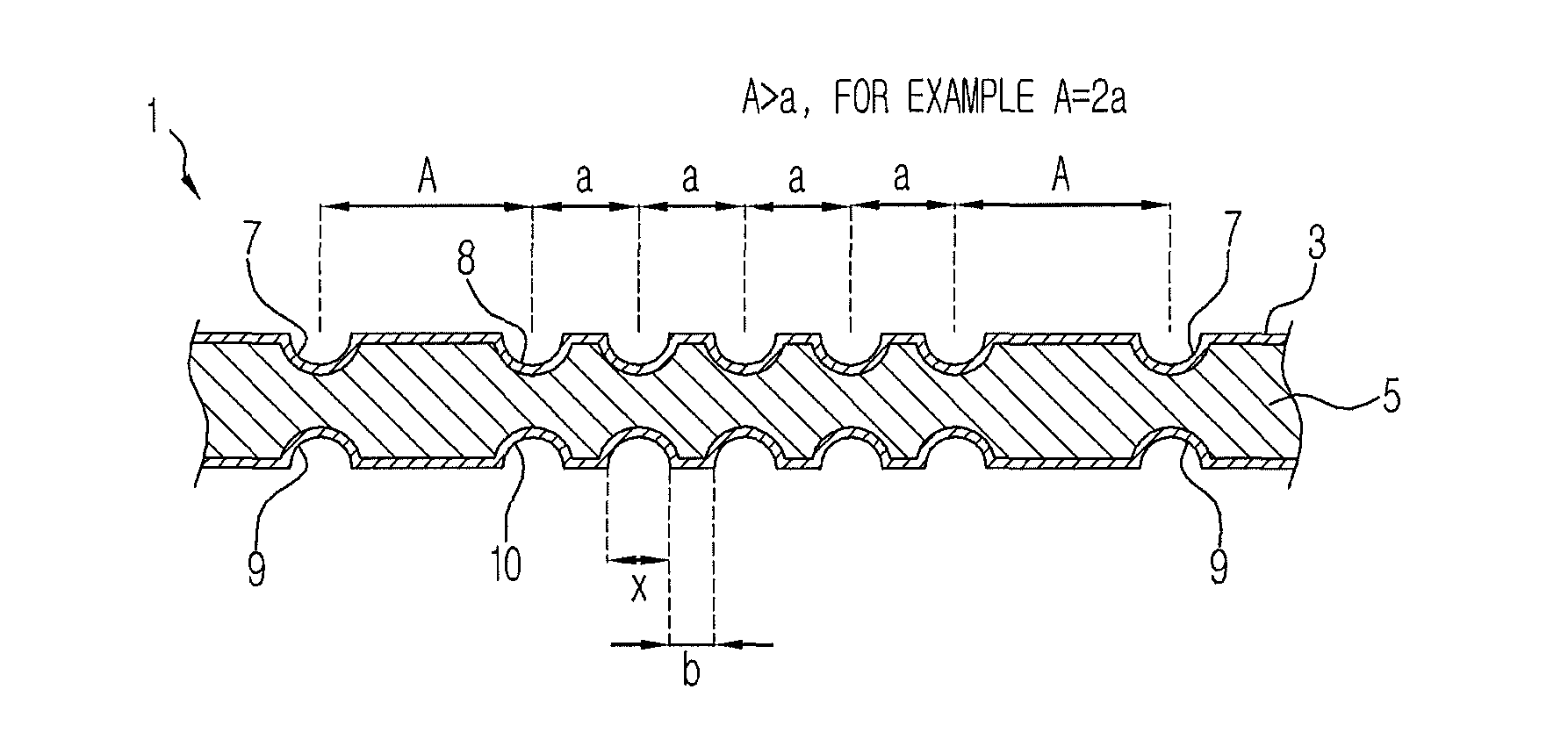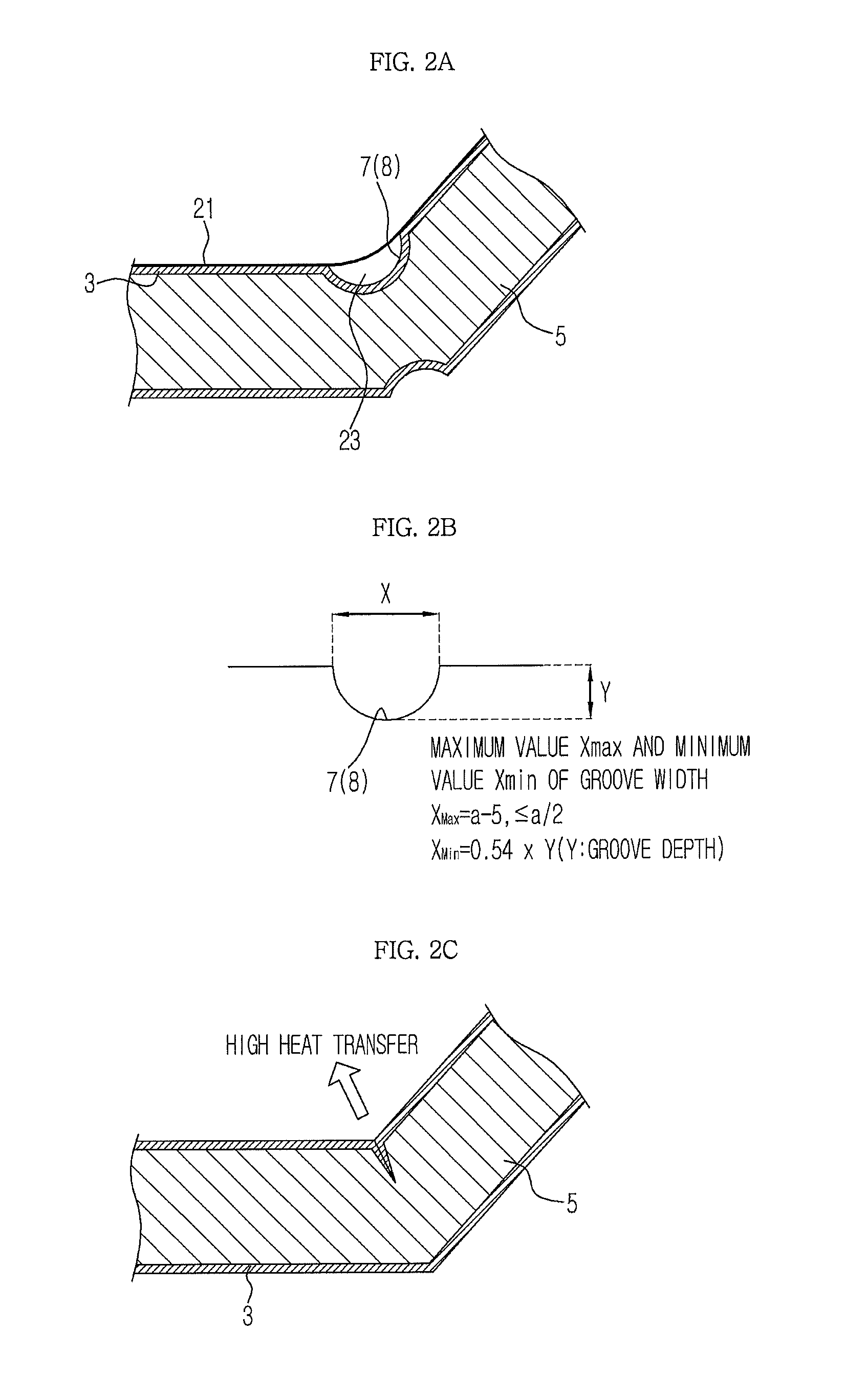Vacuum insulation material, insulation case unit, and refrigerator
a vacuum insulation material and insulation case technology, applied in the direction of insulation for cooling apparatus, domestic cooling apparatus, lighting and heating apparatus, etc., can solve the problems of insufficient restraint of the encapsulator (sheathing material), insulation material not being able to achieve desired insulation performance, and insulation material not being able to achieve the desired insulation performance. , to achieve the effect of excellent bending formability
- Summary
- Abstract
- Description
- Claims
- Application Information
AI Technical Summary
Benefits of technology
Problems solved by technology
Method used
Image
Examples
second concrete example
[0083]A plate-shaped sheathing material having no grooves is manufactured using the above manufacturing method. The sheathing material 3 is a laminate film obtained by coupling a polyamide film having a thickness of 25 μm an aluminum (about 50 nm)-deposited polyethylene terephthalate film having a thickness of 25 μm an aluminum foil having a thickness of 6 μm and a high-density polyethylene film having a thickness of 50 μm using dry lamination. A short fiber glass wool stack having an average fiber diameter of about 4 μm is used as the core 5. An adsorbent is omitted in consideration of measurement.
[0084]The vacuum insulation material 1 according to this concrete example may be manufactured by forming a plurality of grooves at the vacuum insulation material after the vacuum insulation material is formed. That is, an example of a manufacturing process of the vacuum insulation material 1 using the manufacturing method described in this embodiment is as follows. FIG. 10 is a sectional ...
third concrete example
[0093]A vacuum insulation material 1 having a width of 400 mm and a length of 700 mm is manufactured based on construction of the material described in the first concrete example and the manufacturing method described in the second concrete example. The vacuum insulation material 1 has a thickness of about 6 mm and an interval between grooves is as shown in FIG. 6. That is, a plurality of grooves has a groove width of 2 mm and a groove depth of 0.5 mm (±0.2 mm). A bendable region 11 of the vacuum insulation material 1 obtained as described above is folded and bent along the grooves such that the bendable region 11 has an R shape (see FIG. 7A). As a result, the bendable region 11 may be processed to have an R50 shape (i.e. a bending radius of 50 mm). The vacuum insulation material 1 is maintained in this state for three days or more. However, leakage does not occur at the vacuum insulation material 1. In addition, thermal conductivity is measured using a heat flow meter (JIS A 1412-2...
fourth concrete example
[0094]A vacuum insulation material 1 according to this concrete example is obtained by changing the interval between the grooves of the vacuum insulation material 1 according to the third concrete example. Specifically, the interval between the inner grooves 8 and 10 is set to 7.5 mm and the interval between the outer grooves 7 and 9 and the inner grooves 8 and 10 adjacent to the outer grooves 7 and 9 (i.e. the interval between the grooves at the bending start point and the bending end point) is set to 15 mm. As a result, the vacuum insulation material is processed to have an R40 shape (i.e., a bending radius of 40 mm). The vacuum insulation material 1 is maintained in this state for three days or more. However, leakage does not occur at the vacuum insulation material 1.
[0095]When the vacuum insulation material 1 is bent, therefore, shape adaptation of the bendable region 11 may be improved. Consequently, the vacuum insulation material 1 may be formed in a desired shape without leak...
PUM
 Login to View More
Login to View More Abstract
Description
Claims
Application Information
 Login to View More
Login to View More - R&D
- Intellectual Property
- Life Sciences
- Materials
- Tech Scout
- Unparalleled Data Quality
- Higher Quality Content
- 60% Fewer Hallucinations
Browse by: Latest US Patents, China's latest patents, Technical Efficacy Thesaurus, Application Domain, Technology Topic, Popular Technical Reports.
© 2025 PatSnap. All rights reserved.Legal|Privacy policy|Modern Slavery Act Transparency Statement|Sitemap|About US| Contact US: help@patsnap.com



